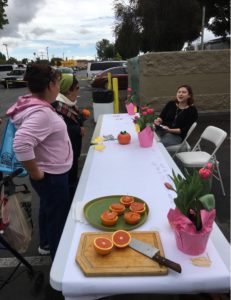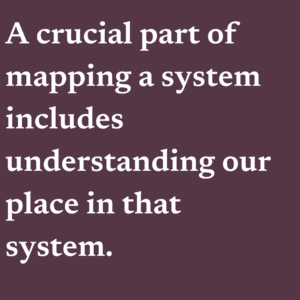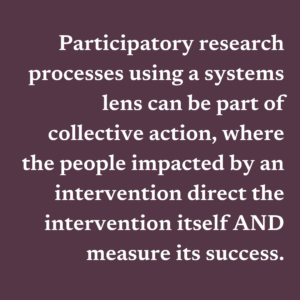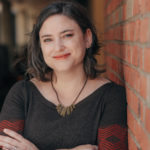Systems Check
By Susannah Laramee Kidd, PhD
I unknowingly joined the field of creative placemaking research in 2015 when I became an embedded evaluator for the “Creative Graffiti Abatement” project, then already underway in South Los Angeles County. I was a budding applied researcher and evaluator, with a tiny bit of prior local government experience, and zero subject matter expertise in cultural policy, community development, or urban planning. I did have sophisticated qualitative research and deep listening skills, honed during a fieldwork-based PhD in the anthropology of religion, literature, and gender. And I had a strong hunch that these skills would be helpful in tracing the dynamics and impacts of community-based arts and cultural strategies.[1]
Evaluating Creative Placemaking Then, Through the Lens of Now
So, to develop my evaluation approach, I listened carefully to my arts colleagues who were experienced practitioners. They had their own hunches and hypotheses to test, formed during their work alongside neighbors and community institutions. Since I was new to the Los Angeles region as well as the field, I also spent time understanding the neighborhoods we were working with. I looked at demographics and other community-level datasets, yes, but I also listened to how residents and county staff experienced these sites. I came to understand some of the histories in each place and the current issues they were grappling with. Coming with East Coast pre-conceived notions about graffiti as primarily a form of cultural expression, I learned that many residents in South Los Angeles County neighborhoods experienced graffiti as markers of gang territory. In this case, graffiti, especially in park spaces, sent a signal about who and what activities are welcome in that public space. Other residents were not overly concerned about graffiti, since the County generally removed graffiti before anyone noticed it. These residents were more concerned about signs of general neglect and lack of investment in their public spaces.

Chatting with community members at East Rancho Dominguez Park in South Los Angeles County. (Photo credit: Sara Daleiden)
In this context, the “Creative Graffiti Abatement” project produced physical artworks and cultural programming at two parks and two libraries. To understand how these artworks and programs transformed spaces, I was watching the social layers of the artistic approaches, with an eye towards how transformed relationships to spaces might correlate to transformed ways of relating to local government and to each other. Using arts and cultural strategies, the projects were trying to bridge differences between cultural groups, such as long-time Black/African-American residents and newer residents from Latinx backgrounds. All the engagement processes were aimed at facilitating collaboration between neighbors to shape the artworks in the immediate term, but also building a foundation for a more active role in shaping their public spaces together. Ultimately, these were demonstration projects designed to imagine new approaches for embedding arts and cultural programming into other civic spaces.
The theory of change embedded in the project design was that increasing engagement prior to, during, and after the installation of artworks would increase engagement with and a sense of attachment and ownership of these civic spaces.[2] I tried to orient myself to how others were assessing the outcomes of similar kinds of projects, but I found little that captured the complexities of the social and cultural dynamics of making artistic interventions in a “place.” The socio-ecological model that I encountered in public health showed promise. As did research that pointed to collective efficacy (a.k.a. collective power) and social cohesion as strong levers for reducing crime and creating healthy communities.[3] But most indicator systems did little to capture the unintended harm in the processes and inequitable outcomes of simply adding arts and cultural strategies to traditional economic development approaches. Therefore, attempts to come up with indicators and measurement strategies were ultimately unsatisfactory.[4] In other words, these approaches were not taking into account that spaces are made into “places” by inequitable cultural, racial, social, and economic systems.
Maturing into Systems Analysis
As a synthesis of the insights gathered across community development sectors, the “Creative Placemaking Research” interactive tool encapsulates how the field has matured in its understanding of how arts and cultural strategies can contribute to equitable community development. The inclusion of three categories of contributions in the infographic—physical, social, and systemic—indicates a necessary level of sophistication in creative placemaking research that matches the complexity of places themselves and creative placemaking practice. The representation of these categories as concentric circles is even more telling. This “nested” image shows us how arts and cultural strategies can and do intervene on each of these three layers at the same time, because every “place” is made up of these layers. I offered the story of the “Creative Graffiti Abatement” project above through the lens of the list of contributions as a brief illustration of how a creative placemaking strategy might operate on and be evaluated in all of three of these spheres. A fuller systems analysis would illuminate how racialized capitalism and settler colonialism continue to affect the particular neighborhoods in the project. But, as a thought experiment, the vignette shows that the contributions listed in this interactive tool can reflect the strategies and potential benefits in the practice of creative placemaking.
 My own work as an evaluator and researcher in the field has matured as well, thankfully, and I’m growing into systems change evaluation as part of my toolkit that aligns with my ethnographic research orientation.[5] As creative placemaking researchers and evaluators, just like creative placemaking practitioners, we must incorporate systems thinking and analysis into our approaches. The first step is to understand the system an arts and cultural strategy is trying to shift and the underlying conditions that can determine the outcomes. These days, I find that in my evaluation coaching and capacity building work, we are spending most of our time articulating the theories of change embedded in an arts and cultural strategy. Then, we can start to trace the potential impacts of an arts for change strategy, and we can plan for how we will know if we have achieved them. Frameworks like the Aesthetic Perspectives attributes, and now this Creative Placemaking Research diagram, can be extremely useful in this process of mapping the intended and potential unintended outcomes of a systems change effort by providing language for the range of possibilities to consider.
My own work as an evaluator and researcher in the field has matured as well, thankfully, and I’m growing into systems change evaluation as part of my toolkit that aligns with my ethnographic research orientation.[5] As creative placemaking researchers and evaluators, just like creative placemaking practitioners, we must incorporate systems thinking and analysis into our approaches. The first step is to understand the system an arts and cultural strategy is trying to shift and the underlying conditions that can determine the outcomes. These days, I find that in my evaluation coaching and capacity building work, we are spending most of our time articulating the theories of change embedded in an arts and cultural strategy. Then, we can start to trace the potential impacts of an arts for change strategy, and we can plan for how we will know if we have achieved them. Frameworks like the Aesthetic Perspectives attributes, and now this Creative Placemaking Research diagram, can be extremely useful in this process of mapping the intended and potential unintended outcomes of a systems change effort by providing language for the range of possibilities to consider.
A crucial part of mapping a system includes understanding our place in that system. Hand and Sherman model this critical self-reflection in their “About” essay, which locates the authors as white women and also how the “field” of creative placemaking has caused harm because it has not been self-conscious about its role in perpetuating racism and other oppressive systems. A lack of critical self-awareness and intentionality can only lead to supporting systems that are operating as they have been designed to operate, namely to accumulate land and resources to white people and affluent groups. This is why early attempts to measure the outcomes of creative placemaking were ultimately insufficient. Without awareness of what it would truly look like to disrupt the systems in place, what looked like success—higher property values and quality of life metrics—only masked the system working as it was intended—displacement and profiting from the disinvestment of Black, Indigenous, and other communities of color.
Pathways for Research into and for Disrupting the System
As an evaluator who often works with public and private grantmakers, this critical self-awareness also means being critical of the role of evaluation as a tool of the nonprofit industrial complex. For practitioners and researchers alike, systems analysis can help us be clear-eyed about the positive or negative impacts of our interventions in the ongoing legacies of racism and other oppressions. Beginning with our values to fight against racism and oppression by starting with a systems analysis and continuing to center those values in our processes of assessment and knowledge generation will be key.
While all the contributions to systems change in the “Creative Placemaking Research” diagram are promising, there are three that offer particular promise for further research into how place-based arts and cultural strategies can disrupt racist and oppressive systems, and how the research processes themselves can partner in systems change efforts. The first is by centering people and their experience of these systems. Research strategies that center the lived experiences of historically and currently marginalized communities can help us to map how oppressive systems are operating in a particular place. Qualitative research approaches like ethnography and participatory narrative inquiry[6] can give us more nuanced understandings of the complexity we need to grasp.
 The second is by building collective power. The “WE-making” suite of resources[7] offers a theory of change, case studies, a conceptual framework, and a literature review about how arts and culture can unite people to work together for community well-being. In working with practitioners to flesh out the theory of change, it was very clear that community-driven analysis of the underlying conditions of racism and other oppressions needed to be the starting place for arts and cultural strategies to ultimately contribute to building social cohesion as a foundation for systems change. Even so, one of the takeaways from the process of making these resources was that further research is needed to provide direct evidence of the relationship between place-based arts and cultural strategies, social cohesion, and equitable community well-being. Participatory research processes using a systems lens can be part of collective action, where the people impacted by an intervention direct the intervention itself AND measure its success.
The second is by building collective power. The “WE-making” suite of resources[7] offers a theory of change, case studies, a conceptual framework, and a literature review about how arts and culture can unite people to work together for community well-being. In working with practitioners to flesh out the theory of change, it was very clear that community-driven analysis of the underlying conditions of racism and other oppressions needed to be the starting place for arts and cultural strategies to ultimately contribute to building social cohesion as a foundation for systems change. Even so, one of the takeaways from the process of making these resources was that further research is needed to provide direct evidence of the relationship between place-based arts and cultural strategies, social cohesion, and equitable community well-being. Participatory research processes using a systems lens can be part of collective action, where the people impacted by an intervention direct the intervention itself AND measure its success.
Finally, there is an opportunity for further research into how creative placemaking efforts can generate new resources. In other words, we need to understand more about how place-based arts and cultural strategies can contribute efforts to push against and build something otherwise to racialized capitalism and its use of land development as a tool of extraction. The place-based systems of oppression and the scarcity mindset around resources that they produce are deeply entrenched and complex. We have barely scratched the surface in terms of understanding of the levers of systems change[8] in this area and how arts and cultural strategies, themselves part of capitalist systems, can contribute to creating change. My point is that none of these is neutral. The place-based arts and cultural strategies, the research approaches, even strategies to build collective power—they are all enmeshed in racism and other oppressive systems. We need to check ourselves and where we stand in these systems, if we are going to create systems change together.
Notes
[1] This was also the hunch that brought the funding for my position. I had come to the, now named, Los Angeles County Department of Arts and Culture as part of the Mellon-ACLS Public Fellows program. The program placed recent humanities and humanistic social science PhDs in public sector and nonprofit settings, with a strong belief in the relevance of advanced humanistic training for the public and nonprofit sectors.
[2] Susannah Laramee Kidd, “Art as Infrastructure: An Evaluation of Civic Art and Public Engagement in Four Communities in South Los Angeles County” (Los Angeles County Arts Commission, May 9, 2018). For the full evaluation report and documentary film materials visit https://www.lacountyarts.org/civic-art-four-stories.
[3] For a further elaboration of how this research connects to place-based arts and cultural strategies, see Rachel Engh et al., “WE-Making: How Arts & Culture Unite People to Work toward Community Well-Being” (Easton, PA: Metris Arts Consulting, 2021). https://metrisarts.com/white-papers-reports/#WE-Making
[4] For more information on an attempt to validate creative placemaking outcome indicators, see Elaine Morley and Mary K. Winkler, “The Validating Arts and Livability Indicators (VALI) Study: Results and Recommendations” (Washington, DC: National Endowment for the Arts, 2014).
[5] Joelle Cook and Hallie Preskill, “How Do You Evaluate Systems Change? A Place to Start.,” FSG Reimagining Social Change (blog), November 22, 2019, https://www.fsg.org/blog/how-do-you-evaluate-systems-change-place-start/.
[6] Cynthia F. Kurtz, Working with Stories in Your Community or Organization: Participatory Narrative Inquiry, Third (Kurtz-Fernhout Publishing, 2014), https://www.workingwithstories.org/aboutpni.html.
[7] Engh et al., “WE-Making: How Arts & Culture Unite People to Work toward Community Well-Being.” https://metrisarts.com/white-papers-reports/#WE-Making
[8] Donella Meadows, “Leverage Points: Places to Intervene in a System,” n.d., https://donellameadows.org/archives/leverage-points-places-to-intervene-in-a-system/.
 Susannah Laramee Kidd, PhD is a queer, cis-gendered, white woman, who was born and raised in and is happy to be based again in Philadelphia. An ethnographer turned arts and culture researcher, evaluator, and strategist, she works with artists, government agencies, arts and community development organizations, and community members to create frameworks that generate learning for social change from the ground up. Previously, she was a Mellon/ACLS Public Fellow at the Los Angeles County Department of Arts and Culture, where she evaluated public art and engagement projects at parks and libraries. You can learn more about her work at www.larameekidd.com.
Susannah Laramee Kidd, PhD is a queer, cis-gendered, white woman, who was born and raised in and is happy to be based again in Philadelphia. An ethnographer turned arts and culture researcher, evaluator, and strategist, she works with artists, government agencies, arts and community development organizations, and community members to create frameworks that generate learning for social change from the ground up. Previously, she was a Mellon/ACLS Public Fellow at the Los Angeles County Department of Arts and Culture, where she evaluated public art and engagement projects at parks and libraries. You can learn more about her work at www.larameekidd.com.
